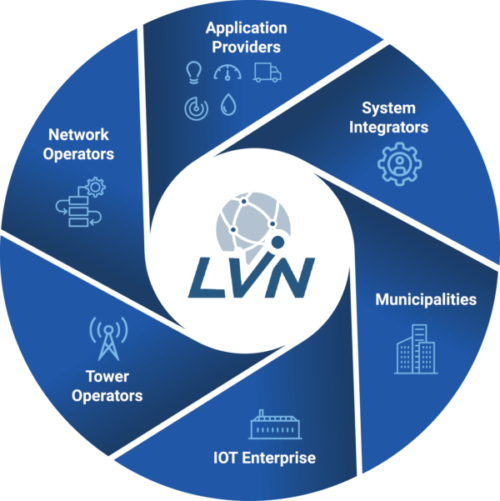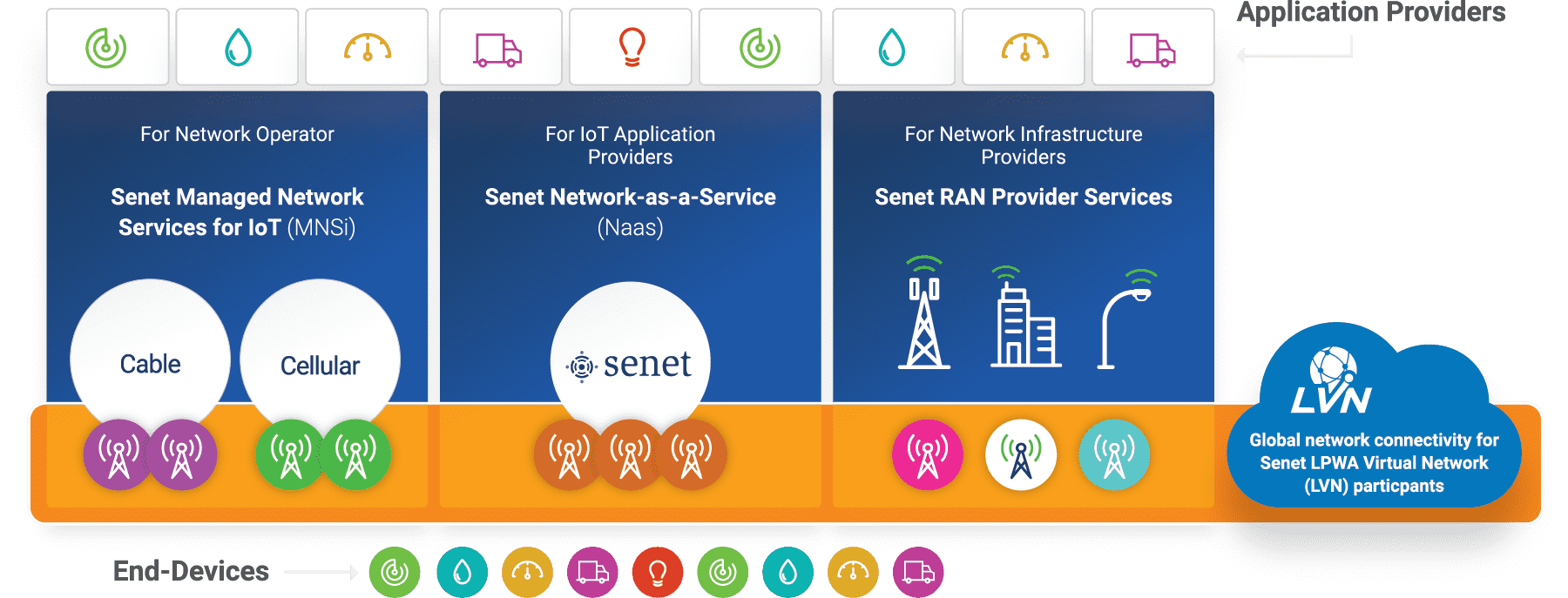The Senet Low Power Wide Area Virtual Network (LVN™)
Changing the Paradigm for How IoT Services are Delivered and Monetized

Join the Largest Global LoRaWAN Network
We’re changing the paradigm for how IoT services are delivered and monetized. Senet’s Low Power Wide Area Virtual Network (LVN™) connects Network Operator, Application Provider and RAN Provider networks under a cooperative model, delivering pervasive and unified connectivity without the need for roaming contracts. Innovative business models allow participation at various levels and benefit from revenue sharing based on the role they play in the larger network ecosystem.
Delivering Ubiquitous Carrier-Grade Network Through a Cooperative Revenue Sharing Model
Successfully commercializing and operating large-scale IoT applications requires transformative network connectivity and business models
Low Power Wide Area Connectivity Where and When You Need It
Applying legacy connectivity models to IoT doesn’t work. Only the Senet LVN provides on-demand network expansion based on the unique geographical and application-specific connectivity needs of your customers and partners.

Senet LVN Revenue Sharing
Unique to the LVN are business models designed for participants to benefit from their investment in the network infrastructure by sharing in the revenue generated by all end devices connecting to the Radio Access Network they’ve deployed.
| LVN Participants | Business Opportunity | Revenue Share |
|---|---|---|
| Network Operators (Cable, Wireless, Fiber, or CLEC) | Expand branded service offerings beyond traditional areas of operation, unlocking opportunities for regional and global growth | Operators are eligible to receive revenue sharing based on participation level |
| RAN Providers | Deploy and manage LoRaWAN Gateways on towers, buildings and municipal assets to deliver IoT connectivity services | Revenue sharing based on participation level and rebate payments from Senet for all traffic passing through your gateway |
| Application Providers | Deploy your application specific gateways and benefit financially from other local LoRaWAN traffic | Generate revenue based on the number of qualified messages connecting to your application’s Radio Access Network |
| System Integrators | Bundle LoRaWAN connectivity with your services and generate new revenue streams by participating in more of the IoT value chain | Operating the network and engaging in customer management (connectivity service billing) enables participation in LVN revenue sharing |
LVN Support and Services
Senet provides a variety of services and support to help LVN participants maximize their business opportunity.
LoRaWAN Gateway Selection
Senet supports LoRaWAN gateways from most commercial vendors. See Senet approved gateway vendor list.
Network Design and RF Planning
- End Node coverage simulation with anticipated performance characteristics
- Redundancy strategies and planning
RAN Site Acquisition
We’ll help you determine where to install the gateways with considerations for:
- Municipality, owned, donated or leased locations
- Permitting
- Power: AC, PoE, Solar
- Internet Protocol backhaul connectivity: Ethernet, Fiber, Cellular
RAN Deployment
- Gateway hardware acquisition
- Provisioning and staging
- Installation – Tower climb, rooftop, billboards, light poles
RAN Management & Operations
- Monitoring (uptime, backhaul, capacity)
- Escalations and alerting
- Trouble calls and truck rolls
Resources for LVN Participants
Learn how you can benefit from our leadership and experience across LoRaWAN technology, global network deployments, markets and applications.
The Senet LVN provides rapidly expanding Low Power Wide Area Network (LPWAN) coverage by connecting Network Operator, Application Provider and Radio Access Network (RAN) Provider networks under a cooperative model. LVN participants partner with Senet to deploy LoRaWAN gateways in support of network expansion strategies and IoT application requirements. This investment in the network infrastructure allows participants to share in the revenue generated by all end devices connecting to the Radio Access Network they’ve deployed.
Operators and RAN Providers participating in the LVN benefit from immediate expansion in coverage area while IoT Application Providers can contribute to the network buildout and provide connectivity services to support the unique geographic and business needs of their customers.
Further streamlining connectivity delivery and management, the Senet LVN supports standardized global device activation and deployment processes, single billing for global device connectivity and cost and connectivity benefits over traditional roaming. In addition, the Senet LVN manages and rates the quality of service delivery for each participant, ensuring a carrier-grade experience.
Traditional network roaming adds expense to data plans, including costs to compensate third-party operators, or worse, technical issues related to the duplication of physical infrastructure and performance degradation due to Physical and MAC layer interference.
A pervasive Radio Access Network (RAN) is necessary to provide IoT connectivity to national or global deployments of IoT end-devices. The Senet LVN uniquely creates a singular federated, cooperative Radio Access Network consisting of gateways supplied and maintained by a variety of RAN Provider Partners. Each RAN Provider deploys network in support of their service geography on assets available to them (towers, buildings, etc.) or in support of an anchor application. The resulting coverage yields a pervasive, unified network that is open and available for use by any Application Provider participating in the Senet LVN – without requiring individually contracted relationships between the Application Provider and any of the RAN Providers. Senet provides the accounting, collection and payment methods to compensate all participating RAN Provider parties and manages and rates the quality of service delivery for each participant, ensuring a carrier-grade experience.
With a diverse set of IoT applications characterized by different demands, there is no “one technology fits all” approach to delivering connectivity for all IoT applications. The emergence of Low Power Wide Area Networks (LPWANs), however, is fundamentally changing the IoT landscape. The cost and functionality gap between cellular and local-area networks has created an opportunity for LPWAN technologies, which excel at enabling low power, long range sensor applications where only small amounts of data are required.
The LoRaWAN® open specification is a low power, wide area networking (LPWAN) protocol based on LoRa Technology. Designed to wirelessly connect battery operated things to the Internet in regional, national or global networks, the LoRaWAN protocol leverages the unlicensed radio spectrum in the Industrial, Scientific and Medical (ISM) band. The specification defines the device-to-infrastructure of LoRa physical layer parameters and the LoRaWAN protocol, and provides seamless interoperability between devices.
Of the billions of IoT sensor-enabled devices expected to be connected over the next few years, more than half are estimated to operate using Low Power Wide Area Networks (LPWANs). Designed for sensors and applications that need to send and receive small amounts of data just a few times per hour or maybe only once a day, LPWANs are transforming the way things are monitored and measured and are contributing to a new wave of IoT innovation resulting in solutions and business models that otherwise would not be possible.
IoT is driving advancements across enterprise and industrial markets, and in vertical industries such as water, gas and electric utilities, agriculture, healthcare and municipal services where it has the potential to streamline operations, deliver time and cost savings and create new services. It is also driving global economic and environmental change with new opportunities for innovation enabling businesses and citizens to make the world a better place.
